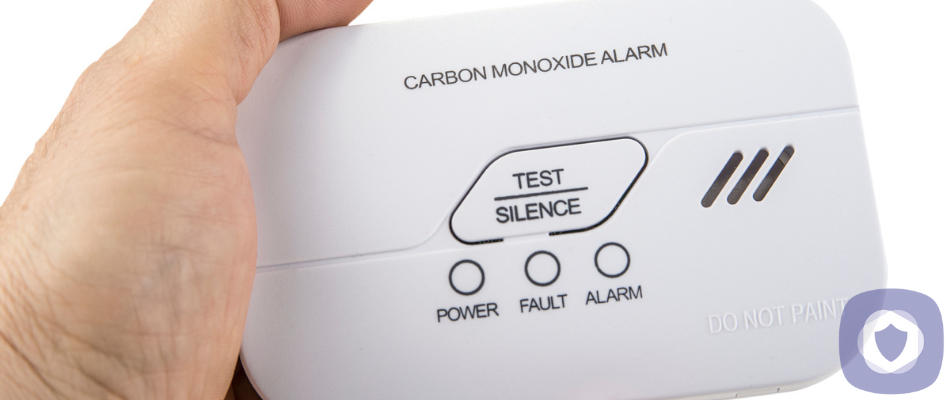Carbon monoxide is produced by burning carbon fuels, such as the engine in your car or the gas stove in your home. Products like barbeques and home heating (particularly water heaters and space heaters) can also produce carbon monoxide. In and of itself, carbon monoxide isn’t fatal. But in higher concentrations and confined spaces, it can become dangerous quickly. Higher concentrations may result due to a malfunction or poor ventilation.
Carbon monoxide poisoning
Carbon monoxide poisoning occurs when carbon monoxide binds to your red blood cells and starves your body of vital oxygen. Breathing in carbon monoxide can cause permanent tissue damage, even without death. Carbon monoxide can kill quickly, but it can also be cumulative and cause damage in the long run.
Symptoms of carbon monoxide poisoning
Early symptoms of carbon monoxide poisoning include:
- Persistent headache
- Nausea
- Abdominal pain
- Weakness
- Dizziness
- Shortness of breath
- Fatigue
People may ignore less severe symptoms of carbon monoxide poisoning as they could be attributed to the flu or a cold. Confusion and unconsciousness can occur when levels of carbon monoxide reach 150 parts per million (ppm).
Preventing carbon monoxide poisoning
Carbon monoxide poisoning is a serious risk, though thankfully, it’s preventable. You can do things to decrease the risk, and it should be part of your home safety plan.
- Running your car in the garage: Few people know that even in an open garage, carbon monoxide can build up quickly. Carbon monoxide is a common byproduct of vehicles via the exhaust. If you want to heat your vehicle in the winter, pull out of the garage first
- Ventilation: Gas-powered home tools, such as pressure washers, generators, and even space heaters, shouldn’t be run in an enclosed area such as a basement without proper ventilation. Carbon monoxide can quickly build to deadly levels if you do this
- Cook safely outdoors: You shouldn’t use a charcoal grill or camping stove in your home or tent. Open flames can be hazardous in a tent for fire safety reasons, but carbon monoxide is a secondary risk
- Gas range safety: It’s a bad idea to heat your home with a gas oven. Gas stoves can fill your home with carbon monoxide very quickly. They should be used to cook in a well-ventilated area, and you should open your kitchen windows while you cook to get fresh air circulating in your home
- Chimney Safety: You should have any chimneys cleaned and regularly inspected, at least yearly
Carbon monoxide detectors
Carbon monoxide is a colorless, odorless gas that is nearly impossible to detect, and it’s virtually impossible to have a carbon monoxide-free home, so it’s vital you’re able to detect an issue before it becomes dangerous. The only reliable way to detect carbon monoxide is with a carbon monoxide detector.
How does a carbon monoxide detector work?
Though there are different types of carbon monoxide detectors, they work similarly. A silicon microchip exchanges information with other detector parts: the chip is fused to a copper-wired electronic circuit panel, which is the unit’s base.
Light-emitting diodes use lights to tell you how the unit functions and if it needs any attention. Newer models may also include an LED panel that shows a readout of CO levels.
Some units are battery-powered, but they may also be wired into the mains. A test/reset button lets you ensure the alarm is working correctly. The CO gas sensor is housed in a detection chamber. The CO sensor identifies and measures CO gas concentration in the atmosphere in parts per million (ppm)
How do different CO sensors work?
Carbon monoxide detectors activate when they sense a particular amount of carbon monoxide or a consistently unacceptable level of carbon monoxide.
Different sensors are alerted in different ways:
- Biomimetic sensor: A gel inside the sensor changes color when it comes into contact with carbon monoxide. This change of color triggers the carbon monoxide alarm
- Metal oxide semiconductor: Electrical currents trigger the alarm when the silica chip detects carbon monoxide
- Electrochemical sensor: electrodes in a chemical solution pick up on changes in electrical currents, which trigger the alarm
The detector will continue until the carbon monoxide is eliminated when the detector is sounding.
What will trigger my carbon monoxide detector?
Your alarm will activate if your sensor detects a buildup of carbon monoxide. The alarm may not go off for several hours with a lower level (50ppm +). Higher levels of about 150ppm will result in a much faster response, usually within minutes.
You should act immediately when your alarm sounds. Each second is vital because even low doses can be as dangerous as sudden exposure in ultra-high doses.
If your carbon monoxide detector goes off
Suppose you’ve familiarized yourself with your alarms’ different sounds (such as the low battery and end-of-life alarms), and you’re sure your sensor has detected carbon monoxide. In that case, you should enact your home safety plan, which must include steps such as these:
- Don’t panic: Get everyone in your house together and move outside quickly and calmly. On your way out, it’s a good idea to open any windows and doors along the way. But don’t endanger yourself to do so
- Survey everyone’s health: Check for any signs of poisoning, such as the symptoms described above. Advise 911 if any of you have symptoms. Carbon monoxide poisoning can be mistaken for the flu
- Stay outside: If possible, don’t reenter your home until your home has been declared safe by emergency responders
- Professional evaluation: To prevent a future incident, you should contact a professional to evaluate any fossil-fuel-burning appliances, including furnaces, boilers, and stoves
Maintaining your carbon monoxide detectors
Irrespective of the type of CO alarm you have, you should maintain it.
- Frequent testing: You should test it frequently; you can do this by pressing the test button on its front. You should do this monthly
- Check the power source: You should replace the batteries as often as required; if your sensor is wired with a battery backup, ensure that the power is working correctly. Detectors with a battery backup are ideal in case of power outages
- Replace the sensor: Your CO detector won’t last forever – you should replace it according to manufacturer guidelines. Many have an expiry of 10 years, but you can clarify this with your alarm supplier
Correct placement of detectors
Like smoke alarms, you wouldn’t just place them randomly. You put them where they’ll be needed. Some states have laws governing this, so you should check your local guidelines. But as a general rule, you should have a sensor per floor and try to ensure that they’re near sleeping areas (for example, in a hallway that leads to several bedrooms is ideal). Our recommendation for a ”standard” family home would be to place one in:
- Kitchen: This is even more important if you have a gas oven
- Upstairs hallway: It’s a sensible idea to place a detector in your upstairs hallway; within a few meters of all bedrooms is ideal. Carbon monoxide poisoning is a bigger risk when you’re asleep
- In the basement: This is even more crucial if you use any power tools that produce carbon monoxide and keep them in the basement
Take a look at our picks for the Best Carbon Monoxide Detectors.
Summing up
Carbon monoxide poisoning is known as ”the silent killer” for a reason. Levels of CO can quickly become dangerous, and you should avoid carbon monoxide exposure at all costs. The only way to reliably avoid carbon monoxide exposure is to ensure that you have well-maintained, reliable alarms installed.
This article has been reviewed and approved by Officer Banta.

Officer Banta is the official SecurityNerd home security and safety expert. A member of the Biloxi Police Department for over 24 years, Officer Banta reviews all articles before lending his stamp of approval. Click here for more information on Officer Banta and the rest of our team.

